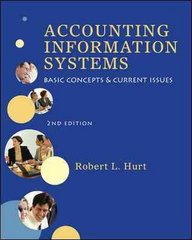Question
TheABC Bank The ABC Bank began operations in the mid-1980s. The bank quickly grew by providing checking account services to many small businesses. Although ABC
TheABC Bank
The ABC Bank began operations in the mid-1980s. The bank quickly grew by providing checking account services to many small businesses. Although ABC initially offered checking account services for individual accounts (retail customers), the bank primarily focused on serving its business customers. During the economic slowdown of the early 1990s that weakened the local economy, growth in business customer accounts began to decline. In response, ABC's senior management adopted a new strategy, focusing on increasing the number of retail customer accounts. By aggressively marketing individual retail accounts, ABC continued to grow. Today, the ABC Bank strives to maintain astable base of business customers, while actively competing for an increased market share of retail customers.
Recentincomestatements(ExhibitA)revealadeclineinthebank'sprofits. Thebank'sprimary(noninterest)expenseconsistsofsalariesandemployeebenefits.Mostfull timeemployees'firstpriorityisprovidingservicestocustomers;theseemployeesconducttheiradministrativeresponsibilitiesduringslack times.TheBankschedules additionalpart timeemployeestoworkduringpeakdemand times, from11AM- 2PMandFridayafternoons.Flexibilityinschedulingpart timeemployeesmeansthatthebank'sstaffisleanandfullyutilized.ABC'sCEO,RobGarrison,believesthatthisstaffingarrangementallowsthebanktoprovidespeedycustomerservice,whileoperatingatpracticalcapacity.(Thatis,thebank's staffisfullyutilizedinefficientoperations,afterallowingforbankholidaysandotherscheduledstaffactivitiessuchastraining.)
Tocounterfallingprofits,ABC'sdirectorstooktwoactionslastyear,bothaimedatincreasingthebank'sretailcustomerbase.First,ABCestablishedaservicecallcentertorespondtocustomerinquiriesaboutaccountbalances,checkscleared,feescharged,andotherbankingconcerns.Second,ABC'sdirectors authorizedyear-endbonusestobranchmanagerswhomettheirbranch'stargetincreaseinthenumberofcustomers.However,eventhough80percentofthebranchmanagersmetthetargetedincreaseincustomeraccounts,theBank'sprofitscontinuedtodecline.CEORobGarrisondoesnotunderstandwhyprofitsaredeclining,giventhattheBankisservingmorecustomers.ABC'ssoutheastregionalmanager,ErikLarsen,hasalsonoticedthatwhilesmallretailcustomersflocktothebank,thenumberof businesscustomersisbarelystable.
ErikLarsensuspectsthatABC'scostingsystemmaybepartoftheproblem.ABCdevelopeditssimplecostingsystemwhenthebankbeganoperationsin1985.Thebankdoesnottraceanycostsdirectlyto individualcustomers. It simplytreatsall(noninterestexpense) operatingcosts,except $955,000 of other operating expenses such as CEO salary,identifiedintheIncomeStatementinExhibitAasindirectwithrespecttothecustomerline.Thebankallocatestheseindirectcoststoeithertheretailcustomerlineorthebusiness customerline,basedonthetotaldollarvalueofchecksprocessed(whichisreadilyavailablebecauseeachbranchmustprovidethedollarvaluesofdailytransactionsforinternalcontrol).Forthecurrentperiod,ABCprocessedatotalof $95millionin checks,of which$9.5millionwaswrittenbyretailcustomers,and $85.5millionwaswrittenbybusinesscustomers.ThiscostingapproachwasfairlytypicalofbanksandotherfinancialinstitutionsatthetimeABCdeveloped itscostsystem.
Incollege,Eriklearnedaboutanalternativecostingapproachcalledactivitybased costing(ABC).However, theexamplesherememberedinvolvedmanufacturingfirms.HewonderedwhetherABCcoulddevelopanABCsystem,withthebusinessaccountcustomerlineandtheretailaccountcustomerlineasthetwoprimarycostobjects.ErikapproachedRobGarrisonwiththissuggestion.Robwasskeptical,exclaiming,"Ourprofitsaregoingdown thetubesandyouwantmetospendmoneydevelopinganewaccountingsystem?"However,Erikpersisted,andRobeventuallyauthorizedapilotABCstudyusingthreelocal branchesofthebank.
TheABCimplementationteamincludedErik,themanagersofeachofthethree bankbranches, a bankteller,andarepresentativefromthecustomerservicecall center.TheteambeganbyidentifyingtheactivitiesABC Bankperformed.Tostartasimplepilotstudy,theteamidentifiedthethreemostimportant activities:
1.Payingchecks
2.Providingtellerservices
3.Respondingtocustomeraccountinquiriesatthecustomerservicecallcenter
Ifthispilotstudyturnedouttobesuccessful,thenthe teamplannedtorefinethesystembyconductingamoredetailedactivityanalysisthefollowingyear.
TheABCteambeganbydeterminingthecoststhatareassociatedwitheachof thethreeactivities.Theteamquicklydiscoveredthat,asistypicalinserviceindustrieslikebanking,labor(personnel)costsdominate.TheABCteamaskedeachemployeetofilloutashortquestionnairetofindouthowtheemployeespendshisor hertime.Theteamthenfollowedupwithanin-depthpersonal interviewwitheachemployee.TheABCteamusedthiscombinedinformationtoestimatethepercentageoftimeeachemployeespentoneachofthethreeactivities:(1)payingchecks,(2)providingtellerservices,and(3)respondingtocustomeraccountinquiries.
Theteamthenestimatedtheother(non-labor)resourcesthateachofthethreeactivitiesconsumed.Forexample,theytracedtothe"respondingtocustomeraccountinquiry"activity:(1)thecostoftoll-freetelephonelinesatthecustomerservicecallcenter,and(2) depreciationonotherequipmentandfacilitiesthecallcenterpersonneluse.Similarly,theABCteamestimatedthepercentageoftimethebank'sinformationsystemwasusedforcheckprocessingandprovidingtellerservices(vs.otherusessuchascompilingperiodicfinancialstatements),todeterminehowmuchoftheequipment'sdepreciationtoassigntotheactivities"payingchecks"and "providingtellerservices."
Tocompletethepilotstudyinatimelyfashion,theABCteambasedtheirestimatedactivitycostsonlastyear'sactualdata,whichwerealreadyavailable.Ifthepilotstudysucceeded,thentheABCteamplannedtodevelopbudgetedindirectcostratesforeachactivitythefollowingyear.Theadvantageofbudgetedratesoveractualratesbasedontheprioryear'sdataisthatbudgetedrates(budgetedcostassociatedwiththeactivitydividedbythebudgetedquantityoftheactivity'scostdriver)canincorporateexpectedchangesin costsandoperations.
Afterexaminingthethreebranchbanks'indirectcosts (thatis,thecostitems makingupthebranchbanks'noninterestoperatingexpenses),theABC teamclassifiedtheannualcostsineachactivity'scostpool[1](hereafter,allnumbersareinthousands) asshowninExhibitB.
Theteamidentifiedthefollowingcostdrivers[2]foreachactivitycostpool:
ActivityCostPool
Activity Cost Driver
Payingchecks
Numberofchecks
Providingtellerservices
Numberoftellertransactions
Responding tocustomer accountinquiries
Numberofaccountinquirycallstocustomerservicecallcenter
TheABCteamestimatedthatforthethreepilot testbankbranches,the retailandbusinesscustomerlinesexperiencedtheannualactivitylevels(inthousands)asshowninExhibitC.Forexample,ExhibitCrevealsthatretailcustomershad160,000tellertransactionsandmade95,000 accountinquirycallstothe customerservicecallcenter.
ABC Bankcurrentlyservices150,000retailcustomerchecking accountsand50,000businesscustomercheckingaccounts.Thebankearnsnetinterestrevenueonthebalancesthatcustomerskeepintheircheckingaccounts.[3]Onaverage,thebankearnsthefollowingannualrevenue(both interest and non-interest)fromeachtypeofaccount:
Avg.annualrevenueperretailcustomeraccount$10
Avg.annualrevenueperbusinesscustomeraccount$40
Required:
1.Compute the profit (loss) per customer for the retail customer and business customer first using original cost system then using the ABC System. Use costs shown in Exhibit B for this purpose.

Step by Step Solution
There are 3 Steps involved in it
Step: 1

Get Instant Access to Expert-Tailored Solutions
See step-by-step solutions with expert insights and AI powered tools for academic success
Step: 2

Step: 3

Ace Your Homework with AI
Get the answers you need in no time with our AI-driven, step-by-step assistance
Get Started


